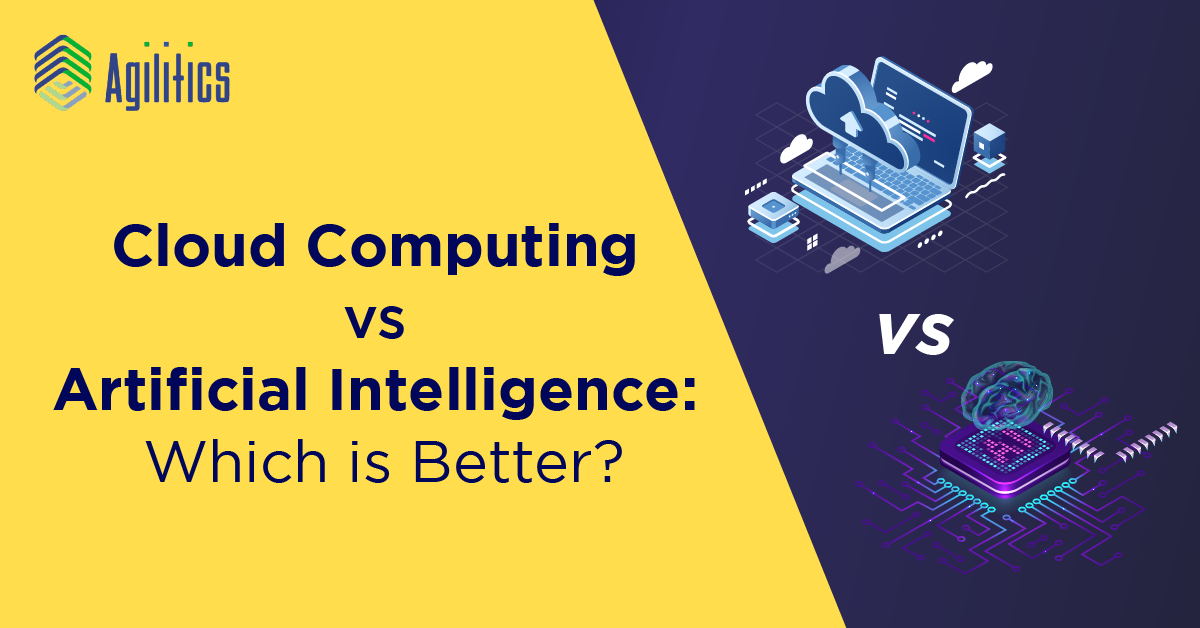Cloud computing and artificial intelligence – of these two technologies that are not just close friends but brothers because they are running on the same cloud. It is hard to say which one is greater in size, but the brilliant artificial intelligence has surpassed her younger brother Cloud Computing by an extensive margin in popularity.
The rising popularity of AI can be seen in the variety of commodities surrounding us. Items infused with artificial intelligence or programming revolutionize the industry, and instances can be located in machine learning and artificial intelligence in finance. Such items include software that acts like digital librarians and takes the form of telepathic toothbrushes or even machine learning and artificial intelligence in cyber security.
AI may be thought of, and perhaps logically so, as just another popular fad, but what if it is here to stay? Indeed, machine learning seems to be the future of human civilization and comprehending the same thoroughly. One needs to grasp the significant role which AI has in our society. For that very reason, taking a glance at the technology that drives the Renaissance of the machines may be of interest to some, as artificial intelligence in CRM is becoming popular.
Machine Learning, as such, can be thought of as AI research but one of a more cutting-edge variety. Regular programs, despite being pretty valuable for their particular field – that is, in performing the task they were created to do – are very redundant concerning their instincts. They are like obsolete dinosaurs who can chase their prey but cannot drive cars.
Data scientists deliberate on the idea of more cognitive complexity being the reason behind the creation of AI that is intelligent. As such, this is where machine learning as a concept comes in.
Now that we have delved into AI let us look at the opposite or perhaps a shifted aspect on the spectrum.
What is Cloud Computing, and what does it mean for me?
Cloud computing is a model for delivering information technology services where resources are retrieved from the internet through web-based tools. This allows businesses to access their data and programs anytime, anywhere there is an internet connection. Cloud computing is a topic of rising importance in the modern business domain. We recommend researching this on your own to better understand its growing role in today’s computer industry.
The market for high-ranking technology has been affected highly by cloud computing. The contemporary AI developments also lead to increasing problems and tribulations for programmers, who aspire to perform their duties in the cloud computing era. The impacts of cloud tech on the market are hardly an unknown variable, as most businesses have come to know, understand and approach the same for their means. However, what remains unclear is the extent to which this technology might change, evolve or devolve in the future.
With time, the changing face of tech needs to be adopted and embraced by various businesses to remain competitive. Since the world is increasingly gearing up to face the ramifications of Cloud Technology in the 21st century, the juxtaposition of Cloud tech with AI becomes an essential factor to consider while making business decisions. The popular belief is that AI has to enhance and influence the cloud, just like AI development is enriched by cloud technology.
The fascination with artificial intelligence can be traced back to the days of the earliest science fiction, with automatons and robots occupying the pages of novels by Isaac Asimov and Philip K Dick and the earliest classical texts. The interest in creating a being that serves us and makes our lives easier attests to the popularity of AI. However, the very idea of AI in practice is arguably much less fantastical than what we tend to imagine. Machine learning and artificial intelligence in banking make for a smoother process, while machine learning and artificial intelligence in hematology reduce the chances of error.
How AI Functions
The ability of machines to perform human-like tasks, in both the cognitive and programming capacity, can let them learn skills independently despite not possessing explicit commands. Through deep learning and machine learning, AI analyses all forms of deep data through the specific use of neural networks. The time crunch is solved by AI-powered machines that can perform high-volume tasks. How businesses use cloud computing has been affected by the emerging AI technology. Human brains serve as the model for developing artificial intelligence.
A vast number of neurons, about 86 billion, make up our grey matter, with each of these neurons acting as a low-power processor connected in a network. Such a network can perform extremely complicated stuff like the interpretation of visual information. Artificial neural networks, which make up AI, consist of several nodes or neurons organized into various layers, each node connected to multiple nodes in the next layer.
Artificial Intelligence is often used as a blanket term to define various things. For example, machines deemed to have human or almost-human-like intelligence and thinking capacity can be called artificially intelligent. In other words, their intelligence, despite being human-like, is artificial and not natural. AI may also refer to specific programming codes without physical codes in cyberspace. Such machines can demonstrate an ability to solve problems and a high cognitive capacity concerning the performance of a specific task.
The first layer can receive raw pictures as input and then transfer data to the next layer of nodes which can make computations or identify faces in pictures. The effortless layers consist of one hidden level, but dozens of the same may be located inside complex systems about deep learning. Of course, every node possesses an added value that is termed weight.
After receiving input, the data is weighed and provided with a specific value. The decision to pass data to the following layer is decided by the multiplied result of the assigned value and the weight of the connection. The data is sent to the next layer only if a product is higher than the node threshold. All the inputs are collected by the final layer, which can conclude. All these functions are highly useful in enhancing cloud computation processes.
How? Let us take a look below to find out: –
1. The Confluence of Powerful Technologies: Cloud and the Impact of AI
As such, AI is becoming increasingly prevalent in new-generation cloud computing infrastructure. This is especially interesting regarding introducing several forms of transforming the technology on mobile like the Internet of Things. New technologies have yet to disrupt the growing landscape concerning cloud computation. As such, both the Internet of Things and the mobile capacities come out as bonuses to the present abilities of a cloud to compute.
Applications based on AI often conflict with the models of IoT and mobiles; they need specific run-time that is optimized for AI solutions that are CPU intensive for GPU. They also possess refined services at the backend. The combination of data, machine learning, and artificial intelligence, along with a healthy dose of new computation skills, would enable both humans and machines to analyze more quantities of data with the cloud. As such, they would be able to get more information than before, such that a combination of these forms of technology would lead to high quantities of data to be handled effectively.
Of course, technophobia is rampant as more machines become human-like. While we may not be looking at a ‘Bladerunner’ or an Isaac Asimov-eques scenario in the recent future, the scare regarding highly efficient machines replacing the human workforce is often talked about today. Such changes are difficult to predict as the alarms are on.
2. Artificial Intelligence In Cloud Computing
With the introduction of AI cloud, businesses have been given a means of bringing their data together and letting machine learning algorithms find patterns and make predictions-and take action based on those predictions. An AI cloud combines the power of an enterprise’s IT system with new processing capabilities, allowing it to support a number of projects that involve both large-scale data analysis and decision making.
Several companies and tech giants have looked at instances of significant investment concerning the capabilities of AI in the cloud. Such companies include Microsoft, IBM, Google, and Amazon.
The Cloud-AI tech that currently exists can be broadly classified into the Cloud Machine Learning Platforms and the AI Cloud Services. The former includes Google Cloud Machine Learning, Azure Machine Learning, and AWS Machine Learning. Services such as these enable one to create models of machine learning which coherently work with all kinds of data.
The second kind of AI can enhance the abstraction of complex artificial intelligence in cloud computation modes. Such firms as Microsoft, Amazon, and Google rule the market of tech giants.
Artificial Intelligence can power the next generations, as cloud computing has become well established. These forms of technology do not upset the already existing landscape of Silicon Valley but seek to enhance the same as a bonus. As discussed earlier, cloud computing technology and AI can enmesh well together to create high amounts of productivity. The distinctive characteristics of artificial intelligence possess the capability to influence the next platform concerning cloud computing.
However, artificial intelligence has distinctive characteristics, influencing the next generation cloud computing platform. AI needs a new computing infrastructure to support new programming frameworks and paradigms. People can expect cloud incumbents to absorb AI capabilities as the foundational element of infrastructures in the future. It is expected that soon everyone will see the emergence of AI-powered new generation cloud platforms. Most AI technologies are being created through cloud computational techniques rather than placing the two at opposing extremes. Companies would do well to embrace both and help them work in tandem. One needs this to store, manage, and even process large quantities of data.
We strive to provide business professionals with the skills and knowledge necessary to increase work performance and drive greater return on investment for the global customers we support. Agilitics delivers customized technology and management training solutions to large corporations and government agencies around the world.


